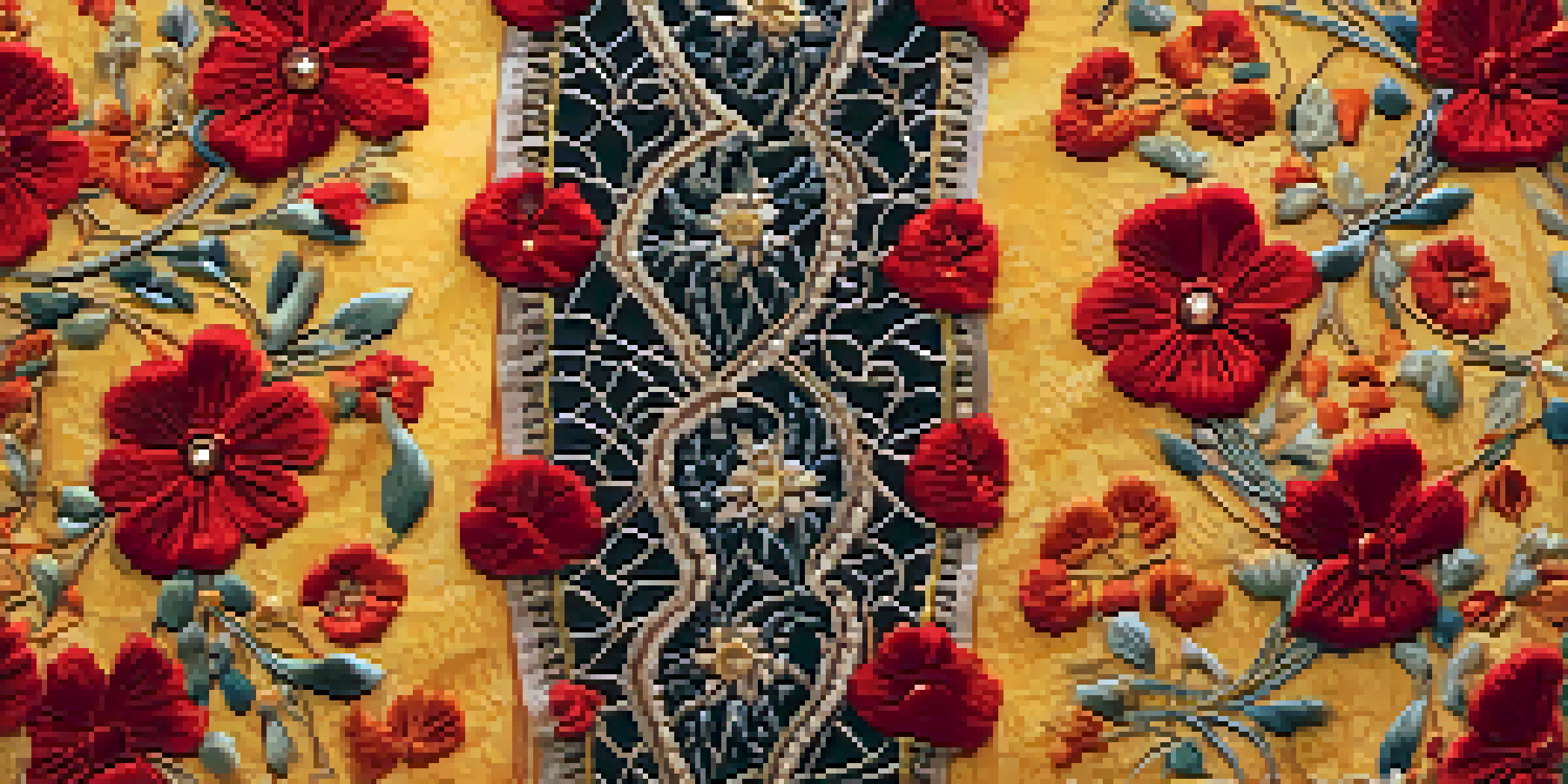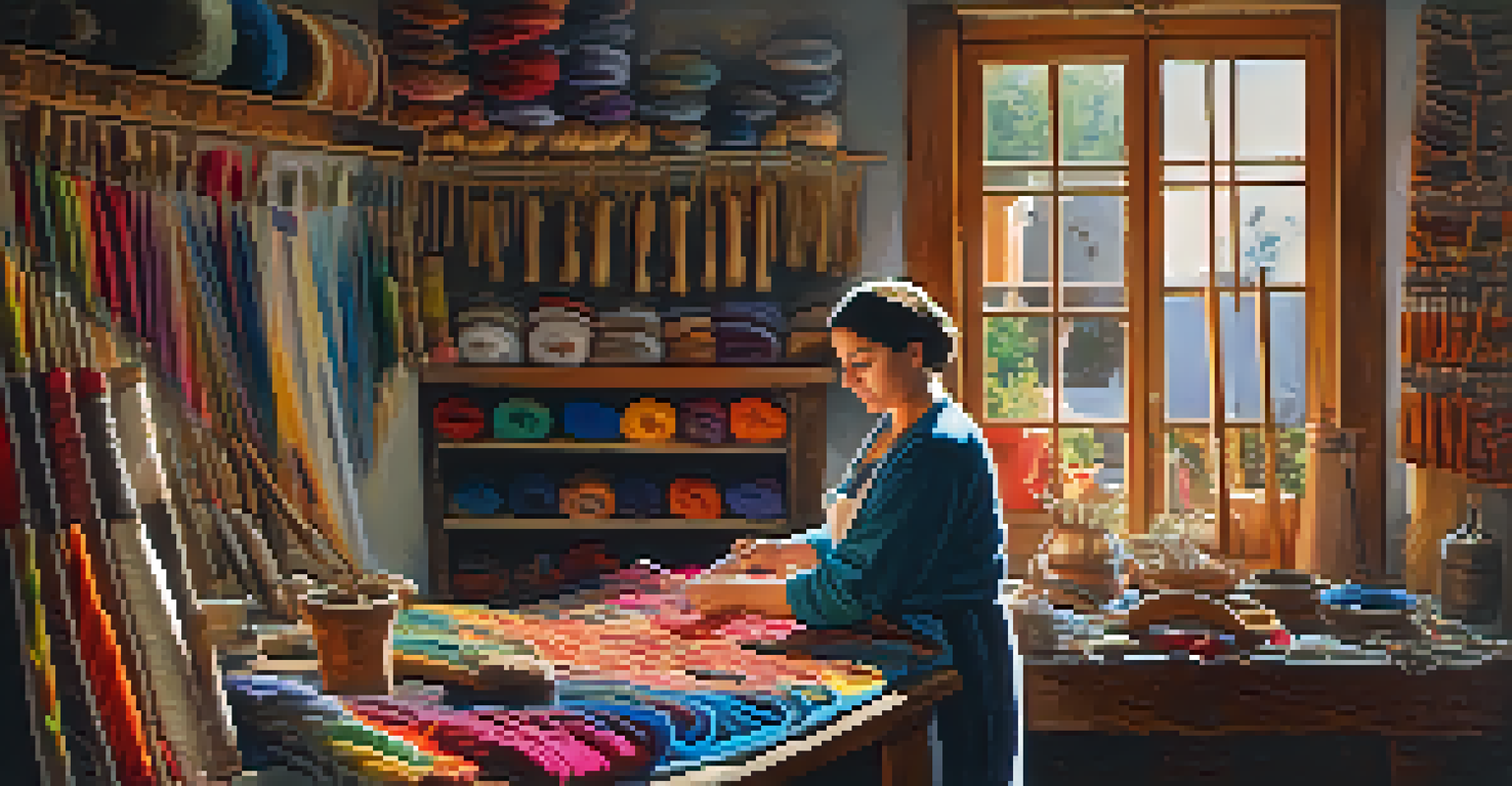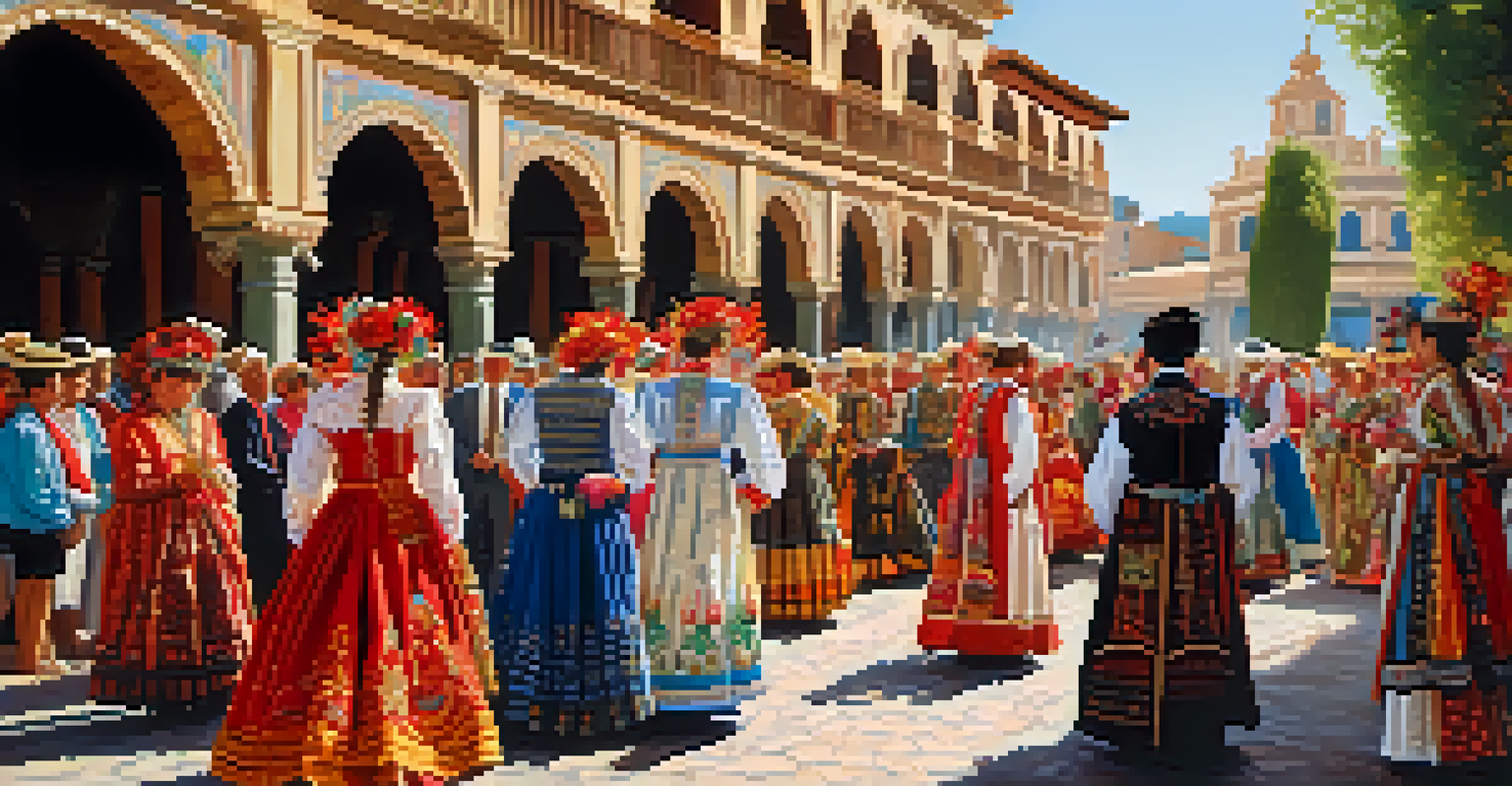The Craft of Spanish Embroidery: Stitching Stories and Culture

The Historical Roots of Spanish Embroidery
Spanish embroidery has deep historical roots, tracing back to the Middle Ages. It reflects the diverse influences of various cultures, including Roman, Moorish, and Christian. Each stitch tells a story, intertwining the histories of the people who created them.
Embroidery is like a journey; it tells a story through every stitch.
Over the centuries, embroidery became a vital part of Spanish identity, used in religious garments, traditional costumes, and decorative art. The intricate designs often symbolize local legends and folklore, making each piece a narrative in itself. This rich tapestry of influences makes Spanish embroidery unique.
Today, many artisans honor these traditional methods while also incorporating modern techniques. The preservation of these skills is crucial, as they connect us to our past and reflect the cultural diversity of Spain. In essence, each embroidered piece is a window into the country's vibrant history.
Understanding Different Techniques and Styles
Spanish embroidery encompasses various techniques and styles, each with its distinct flair. For example, 'bordado' refers to the general act of embroidery, while 'punto de cruz' or cross-stitch is particularly popular for its simplicity and versatility. These techniques vary widely across regions, showcasing local customs.

One notable style is 'bordado a mano' or hand embroidery, which emphasizes meticulous craftsmanship. Artisans use a range of stitches, such as satin, chain, and feather stitches, to create detailed designs. The choice of stitch directly impacts the texture and appearance of the final piece.
Spanish Embroidery's Rich History
Spanish embroidery reflects a blend of cultural influences from Roman, Moorish, and Christian traditions, making it a unique narrative art form.
Moreover, many regions in Spain have their signature embroidery styles, like the vibrant colors of 'bordado de Almagro' or the delicate whitework of 'bordado de Cantabria.' This regional diversity enriches the craft, allowing for endless creativity and expression among artisans.
Cultural Significance of Embroidery in Spain
In Spain, embroidery is more than just an art form; it's a cultural expression. Many traditional garments, such as flamenco dresses and regional costumes, are adorned with intricate embroidery that reflects local customs. These garments often play a key role during festivals and celebrations, serving as a visual representation of cultural pride.
Every piece of embroidery is a reflection of the culture that shaped it, carrying the essence of its people.
Embroidery also holds significant religious importance, especially in the creation of vestments for clergy and sacred art for churches. The carefully crafted embroidery often depicts religious figures and symbols, making each piece deeply meaningful. This intertwining of faith and craftsmanship showcases the reverence for tradition in Spanish culture.
Moreover, younger generations are increasingly embracing this craft, ensuring its continuity. Workshops and classes are becoming popular, allowing people to learn traditional techniques. This revival not only strengthens cultural ties but also fosters a sense of community among artisans and enthusiasts alike.
Exploring Regional Variations in Embroidery
Spain's diverse regions are home to distinct embroidery styles that tell unique stories. For instance, the 'bordado de Granada' features intricate floral motifs, while the 'bordado de Sevilla' is characterized by its vibrant colors and elaborate patterns. Each region's climate, resources, and historical influences shape its embroidery tradition.
In Galicia, you'll find 'punto de cruz' styles that often depict local landscapes or folklore scenes, while in Andalusia, the flamenco dresses showcase bold, eye-catching designs. These variations reflect not only artistic preferences but also the cultural heritage and values of each area.
Diverse Techniques Across Regions
There are various embroidery techniques and styles in Spain, each showcasing the distinct customs and artistry of different regions.
Traveling through Spain, one can appreciate how embroidery serves as a visual language, conveying the essence of a region. The distinct techniques and motifs offer a glimpse into the lives and stories of the people who inhabit these areas, making each piece of embroidery a cherished artifact.
Modern Innovations in Spanish Embroidery
While traditional techniques continue to thrive, modern innovations in embroidery have emerged, blending old and new. Contemporary artists are experimenting with materials and methods, incorporating digital technologies alongside hand-stitched designs. This fusion creates a fresh narrative, appealing to a broader audience.
For example, some artists are using unconventional fabrics or adding mixed media elements, such as beads and sequins, to enhance their work. This evolution demonstrates how embroidery can adapt to current trends while still honoring its rich heritage. It’s a beautiful reminder that art is continuously evolving.
Additionally, social media platforms have played a significant role in showcasing these modern interpretations. Artists can now share their work with a global audience, fostering a community of embroidery enthusiasts. This visibility ensures that the craft remains relevant, encouraging a new generation to explore and appreciate the art of embroidery.
The Role of Embroidery in Spanish Festivals
Spanish festivals are vibrant celebrations often marked by traditional clothing adorned with exquisite embroidery. Events like Feria de Abril in Seville see participants donning beautifully embroidered flamenco dresses, showcasing the artistry and cultural significance embedded in each stitch. These garments are not just for aesthetics; they represent pride and identity.
During religious festivals, such as Semana Santa (Holy Week), ornate embroidered robes and banners are prominently displayed. These pieces often depict religious scenes and are crafted with utmost devotion, reflecting the spiritual connection of the community. The embroidery becomes a vital part of the festival's narrative, enhancing the overall experience.
Embroidery's Role in Festivals
Embroidery plays a significant role in Spanish festivals, where traditional garments adorned with intricate designs symbolize cultural pride and community connection.
Moreover, many festivals provide a platform for artisans to display their skills, fostering appreciation for their craft. Workshops and demonstrations often take place, allowing festival-goers to engage with embroidery firsthand. This connection between craft and celebration keeps the tradition alive and thriving for future generations.
How to Get Started with Spanish Embroidery
If you're eager to dive into the world of Spanish embroidery, getting started is easier than you might think! Begin by gathering basic supplies such as fabric, embroidery floss, and needles. There are countless online resources, tutorials, and kits specifically designed for beginners that can help demystify the process.
Consider joining a local embroidery class or community group to connect with fellow enthusiasts. Not only will you learn traditional techniques, but you'll also gain insights into the cultural significance behind the stitches. Sharing experiences with others can be incredibly inspiring and motivating.

Lastly, don't be afraid to experiment! Spanish embroidery is all about creativity and personal expression, so feel free to incorporate your style into your projects. Whether you’re making a small decorative piece or a larger work of art, each stitch you make contributes to the rich tapestry of this beautiful craft.